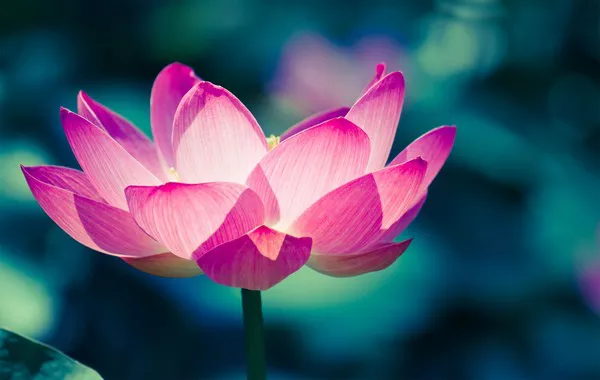The lotus flower holds a special place in cultural, religious, and symbolic contexts across the world. Revered for its stunning beauty and profound symbolism, the lotus flower has captured the imaginations of people for centuries.
Botanical Marvel: The Lotus Flower’s Characteristics
The lotus flower, scientifically known as Nelumbo nucifera, is a remarkable aquatic plant renowned for its unique characteristics. Growing in muddy waters, the lotus has adapted to thrive in environments that might seem inhospitable to other plants. The plant’s large, round leaves, often held above the water’s surface, are water-repellent, preventing them from becoming saturated. This ingenious adaptation allows the lotus flower to maintain its pristine appearance despite its muddy surroundings.
Cultural Origins: The Lotus Flower in Ancient History
The cultural roots of the lotus flower can be traced back to ancient civilizations, where it held profound significance in various mythologies and religious beliefs. In ancient Egypt, the lotus was a symbol of rebirth and regeneration. The image of the lotus was closely associated with the sun god Ra, as the flower’s daily cycle of opening and closing mirrored the sun’s journey across the sky.
Sacred Symbolism in Eastern Religions
The lotus flower is deeply ingrained in the religious and philosophical traditions of the East. In Hinduism, the lotus is associated with divine beauty, purity, and the unfolding of spiritual potential. The goddess Lakshmi, the embodiment of beauty and prosperity, is often depicted sitting on a fully bloomed lotus. Similarly, in Buddhism, the lotus holds immense symbolic value. It is a representation of purity rising above the muck of worldly attachments, mirroring the journey towards enlightenment.
The Lotus in Buddhism: A Symbol of Enlightenment
In Buddhism, the lotus flower is a powerful symbol of spiritual enlightenment. The growth of the lotus from the murky waters to the pristine surface symbolizes the journey from ignorance to enlightenment. The stages of the lotus, from bud to fully bloomed flower, are analogous to the stages of spiritual development. The lotus is also associated with Buddha himself, as it is believed that wherever he walked, lotus flowers bloomed.
Varieties of Lotus Flowers: A Riot of Colors
The world of lotus flowers is diverse, with various species and hybrids showcasing an array of colors and forms. From the classic pink lotus to the serene white varieties and the vibrant hues of blue and purple, each type of lotus flower carries its unique charm. The diverse palette of lotus flowers has further contributed to their popularity in ornamental gardens and religious symbolism.
The Lotus in Chinese Culture: Symbol of Purity and Harmony
In Chinese culture, the lotus flower holds a special place as a symbol of purity and harmony. Similar to its symbolism in other Eastern cultures, the lotus represents the journey to enlightenment. The concept of the lotus is deeply embedded in Chinese philosophy, where it is believed that a virtuous person, like the lotus, can rise above adversity and maintain purity of heart and mind.
Lotus Flower Varieties in Chinese Art and Literature
The lotus has been a recurring motif in Chinese art and literature for centuries. In paintings, poems, and other forms of artistic expression, the lotus flower is often used to convey deep philosophical and spiritual messages. The delicate yet resilient nature of the lotus serves as an inspiration for individuals striving for personal and moral growth.
The Lotus in Modern Symbolism: Beyond Borders and Boundaries
Beyond its historical and cultural roots, the lotus flower has transcended borders and found its place in modern symbolism. Its enduring popularity is evident in various domains, from art and literature to tattoo culture and contemporary design. The lotus flower continues to captivate people worldwide, becoming a universal symbol of beauty, resilience, and spiritual growth.
Lotus Flower: A Botanical Marvel in Western Gardens
In the Western world, the lotus flower has found a place of admiration in gardens and ponds. While it may not have the same cultural or religious significance as in the East, the sheer beauty of the lotus has made it a sought-after addition to botanical collections. The exotic allure of the lotus has led to its cultivation in water gardens, where its elegant blooms and distinctive leaves create a serene and enchanting atmosphere.
Growing Lotus Flowers: A Gardener’s Delight
Cultivating lotus flowers requires a careful understanding of their unique needs. From suitable water conditions to proper sunlight, growing lotus flowers can be a rewarding but challenging endeavor. The process of nurturing these exquisite plants from seed or tuber to full bloom adds an extra layer of appreciation for the botanical marvel that is the lotus.
The Lotus Effect: Inspiration for Sustainable Design
The self-cleaning properties of the lotus flower, known as the “lotus effect,” have not only fascinated scientists but have also inspired innovations in sustainable design. The microstructure of the lotus leaves, which repels water and prevents dirt accumulation, has been studied for applications in creating self-cleaning surfaces for buildings and materials. The lotus effect stands as a testament to the potential synergies between nature and technology.
Lotus Flower in Literature: Poetic and Symbolic Expressions
Throughout literature, the lotus flower has been a subject of poetic expression and symbolic interpretation. From ancient Eastern texts to contemporary Western poetry, the lotus is often used as a metaphor for purity, transformation, and the resilience of the human spirit. Writers draw on the rich symbolism of the lotus to convey profound messages about life, growth, and the pursuit of inner beauty.
Conclusion
In conclusion, the lotus flower stands as a symbol of beauty, purity, and spiritual enlightenment that transcends geographical and cultural boundaries. Its captivating presence in religious iconography, art, and literature throughout history showcases the universal appeal of this botanical marvel. Whether admired in serene Eastern ponds, cultivated in Western gardens, or celebrated in contemporary art, the lotus flower continues to be a source of inspiration, inviting us to reflect on our own journey of growth, resilience, and the pursuit of beauty in all aspects of life.


